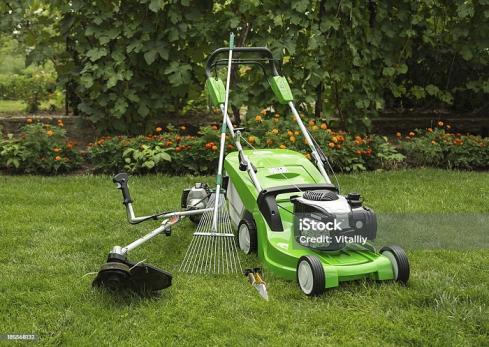For those with genuine love and innate skill for lawn care, the journey from tending to your own lawn to launching a professional landscaping business may be a shorter leap than you think.
What truly makes the difference are the tools employed in the trade, the equipment that forms the backbone of your operations. As you venture into this serious business, your arsenal of tools plays a significant role in your success.
The key to this success, however, lies not just in owning these tools, but in maximizing their performance and longevity.
In this comprehensive guide, we delve into the range of ways you can ensure that your lawn care equipment delivers optimal performance and the best results for your business, starting from the choice of vehicle and essential safety gear, right down to maintenance, storage, and troubleshooting.

Table of Contents
Regular Maintenance of Lawn Care Tools
Make sure you’re regularly cleaning and lubricating your lawn care tools to keep them in optimal condition. Regular maintenance is essential for ensuring that your tools perform at their best and have a longer lifespan.
When it comes to cleaning, use a brush or cloth to remove dirt, grass clippings, and debris from the blades and other parts of your tools. Don’t forget to clean the air filters as well.
After cleaning, apply lubricant to the moving parts of your tools to reduce friction and prevent rust. This will help your tools to operate smoothly and efficiently.
Remember to follow the manufacturer’s instructions for specific cleaning and lubrication techniques for all your lawn care tools.
Maximizing Efficiency: Operating Your Equipment Correctly
Are you utilizing your equipment correctly to maximize efficiency and save time during your lawn care tasks?
It’s essential to understand how to operate your equipment properly to get the most out of it. Start by familiarizing yourself with the user manual and following the manufacturer’s instructions.
Ensure that you’re using the right attachments and accessories for each task. Regularly maintain and clean your equipment to keep it in optimal condition.
Take the time to learn about the different features and settings of your tools, as they can greatly affect performance. Additionally, consider investing in ergonomic tools that reduce strain and fatigue.
Seasonal Adjustments in Equipment Performance
Have you considered how seasonal adjustments can impact the performance of your equipment? It’s important to understand how changes in weather and temperature can affect the efficiency and effectiveness of your lawn care equipment.
Here are four key points to keep in mind:
- Maintenance: Regularly check and service your equipment to ensure it’s in optimal condition for each season. This includes cleaning, lubricating, and replacing worn parts as necessary.
- Fuel and oil: Use the appropriate type and grade of fuel and oil for your equipment, taking into account the specific requirements for each season. Adjusting the fuel-air mixture and oil viscosity can improve performance and prevent damage. STIHLl chainsaws, for instance, have a specific STIHL chainsaw mix ratio for optimal functioning and longevity of the chainsaw’s engine.
- Blade height: Adjust the cutting height of your mowers and trimmers according to the season. For example, in the summer, you may want to mow higher to promote healthier grass growth, while in the winter, a lower cutting height may be necessary to prevent snow and ice accumulation.
- Storage: Properly store your equipment during the off-season to protect it from the elements. This includes cleaning, drying, and storing it in a secure and dry location.
Implementing Effective Storage Solutions for Lawn Care Equipment
To optimize the storage of your lawn care equipment, consider using sturdy shelving units and clear plastic bins to keep everything organized and easily accessible. This solution won’t only save you time and frustration when searching for tools, but it will also help protect your equipment from damage.
Sturdy shelving units provide a stable and secure space to store larger items such as lawnmowers and trimmers, while clear plastic bins are perfect for smaller tools and accessories. By keeping everything in its designated place, you can easily find what you need when you need it.
Additionally, clear bins allow you to see the contents at a glance, eliminating the need for rummaging through multiple containers. Invest in storage solutions that fit your specific needs and create a well-organized space for your lawn care equipment.
Troubleshooting Common Issues in Lawn Care Tools
If you’re experiencing issues with your lawn care tools, try troubleshooting them by following these simple steps:
1. Check for fuel and oil levels
Make sure your tools have enough fuel and oil to operate properly. Low levels can cause them to malfunction or not start at all.
2. Clean or replace air filters
Clogged air filters can restrict airflow and affect performance. Clean or replace them regularly to ensure optimal operation.
3. Inspect spark plugs
Worn or dirty spark plugs can lead to difficulties starting your equipment. Check and clean or replace them as needed.
4. Sharpen or replace blades
Dull or damaged blades can result in uneven cuts or difficulty in mowing. Sharpen or replace them to maintain a clean and well-manicured lawn.
Investing in Quality: The Impact on Performance and Longevity
Investing in high-quality lawn care equipment can significantly improve performance and increase longevity, allowing you to tackle more tasks efficiently. When you invest in high-quality equipment, you can expect better results and fewer breakdowns.
Quality equipment is designed to withstand the rigors of regular use and provide reliable performance. This means you can spend less time on repairs and more time on getting the job done. Additionally, high-quality equipment often comes with useful features and attachments that can enhance your productivity.
By investing in top-notch equipment, you’re making a long-term investment in your business. It may require a higher upfront cost, but the benefits in terms of performance, durability, and efficiency make it a worthwhile investment.
Conclusion
Getting the best out of your lawn care tools is essential for your landscaping business. Regular maintenance, proper usage, and storage will help keep your equipment in top shape. Consider the seasons and adjust your tools’ settings to suit the weather.
If you come across any issues, don’t hesitate to troubleshoot. It’s okay to spend a bit more on high-quality equipment because it’s an investment that will pay off with better results and fewer breakdowns.
Remember, treating your tools right will ensure they perform well, giving your business the boost it needs.
FAQs
Q: How often should I clean and lubricate my lawn care tools?
It’s recommended to clean your tools after each use and lubricate them regularly to keep them in optimal condition. However, please refer to your tool’s manufacturer’s instructions for specific cleaning and lubricating guidelines.
Q: Can I use any type of fuel and oil in my lawn care equipment?
Always use the appropriate type and grade of fuel and oil specified by the equipment manufacturer. Using the incorrect type can lead to poor performance and potential damage.
Q: What sort of safety gear should I invest in for my lawn care business?
Essential safety gear can include work gloves, protective eyewear, sturdy footwear, hearing protection, and safety vests. Always ensure you and your team are adequately protected when operating lawn care equipment.
Q: Is it necessary to replace blades and spark plugs or can they be repaired?
While some parts like blades can be sharpened, others like spark plugs may need to be replaced over time. Always consult the manufacturer’s instructions or a professional for advice.
Q: Should lawn care equipment be stored in a particular way during off-seasons?
Yes, it’s crucial to store tools properly during off-seasons to protect them from the elements. This usually involves cleaning, drying, and storing them in a secure and dry place.




